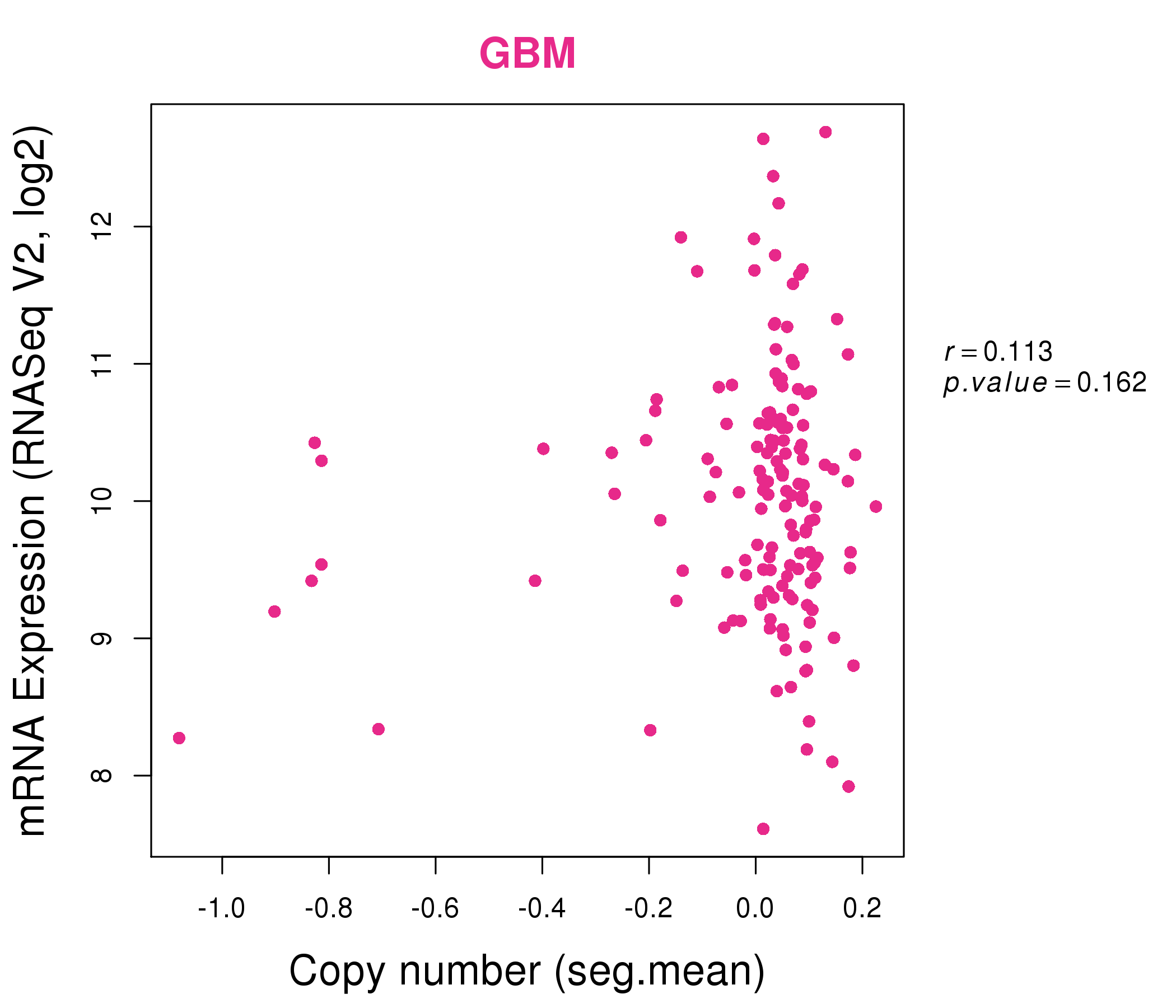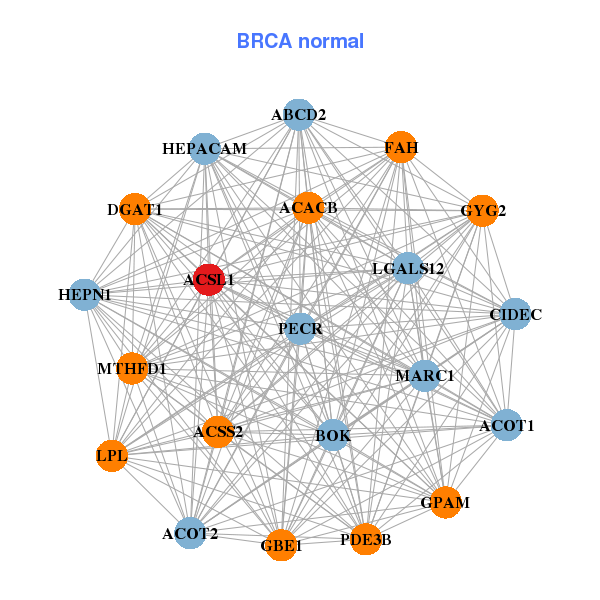|
||||||||||||||||||||
| |
| Phenotypic Information (metabolism pathway, cancer, disease, phenome) |
| |
| |
| Gene-Gene Network Information: Co-Expression Network, Interacting Genes & KEGG |
| |
|
| Gene Summary for ACSL1 |
| Basic gene info. | Gene symbol | ACSL1 |
| Gene name | acyl-CoA synthetase long-chain family member 1 | |
| Synonyms | ACS1|FACL1|FACL2|LACS|LACS1|LACS2 | |
| Cytomap | UCSC genome browser: 4q35.1 | |
| Genomic location | chr4 :185676748-185747215 | |
| Type of gene | protein-coding | |
| RefGenes | NM_001286708.1, NM_001286710.1,NM_001286711.1,NM_001286712.1,NM_001995.3, | |
| Ensembl id | ENSG00000151726 | |
| Description | LACS 1LACS 2acyl-CoA synthetase 1fatty-acid-Coenzyme A ligase, long-chain 1fatty-acid-Coenzyme A ligase, long-chain 2lignoceroyl-CoA synthaselong-chain acyl-CoA synthetase 1long-chain acyl-CoA synthetase 2long-chain fatty acid-CoA ligase 2long-ch | |
| Modification date | 20141207 | |
| dbXrefs | MIM : 152425 | |
| HGNC : HGNC | ||
| Ensembl : ENSG00000151726 | ||
| HPRD : 01068 | ||
| Vega : OTTHUMG00000160547 | ||
| Protein | UniProt: go to UniProt's Cross Reference DB Table | |
| Expression | CleanEX: HS_ACSL1 | |
| BioGPS: 2180 | ||
| Gene Expression Atlas: ENSG00000151726 | ||
| The Human Protein Atlas: ENSG00000151726 | ||
| Pathway | NCI Pathway Interaction Database: ACSL1 | |
| KEGG: ACSL1 | ||
| REACTOME: ACSL1 | ||
| ConsensusPathDB | ||
| Pathway Commons: ACSL1 | ||
| Metabolism | MetaCyc: ACSL1 | |
| HUMANCyc: ACSL1 | ||
| Regulation | Ensembl's Regulation: ENSG00000151726 | |
| miRBase: chr4 :185,676,748-185,747,215 | ||
| TargetScan: NM_001286708 | ||
| cisRED: ENSG00000151726 | ||
| Context | iHOP: ACSL1 | |
| cancer metabolism search in PubMed: ACSL1 | ||
| UCL Cancer Institute: ACSL1 | ||
| Assigned class in ccmGDB | C | |
| Top |
| Phenotypic Information for ACSL1(metabolism pathway, cancer, disease, phenome) |
| Cancer | CGAP: ACSL1 |
| Familial Cancer Database: ACSL1 | |
| * This gene is included in those cancer gene databases. |
|
|
|
|
|
| . | ||||||||||||||
Oncogene 1 | Significant driver gene in | |||||||||||||||||||
| cf) number; DB name 1 Oncogene; http://nar.oxfordjournals.org/content/35/suppl_1/D721.long, 2 Tumor Suppressor gene; https://bioinfo.uth.edu/TSGene/, 3 Cancer Gene Census; http://www.nature.com/nrc/journal/v4/n3/abs/nrc1299.html, 4 CancerGenes; http://nar.oxfordjournals.org/content/35/suppl_1/D721.long, 5 Network of Cancer Gene; http://ncg.kcl.ac.uk/index.php, 1Therapeutic Vulnerabilities in Cancer; http://cbio.mskcc.org/cancergenomics/statius/ |
| KEGG_FATTY_ACID_METABOLISM REACTOME_METABOLISM_OF_LIPIDS_AND_LIPOPROTEINS | |
| OMIM | |
| Orphanet | |
| Disease | KEGG Disease: ACSL1 |
| MedGen: ACSL1 (Human Medical Genetics with Condition) | |
| ClinVar: ACSL1 | |
| Phenotype | MGI: ACSL1 (International Mouse Phenotyping Consortium) |
| PhenomicDB: ACSL1 | |
| Mutations for ACSL1 |
| * Under tables are showing count per each tissue to give us broad intuition about tissue specific mutation patterns.You can go to the detailed page for each mutation database's web site. |
| There's no structural variation information in COSMIC data for this gene. |
| * From mRNA Sanger sequences, Chitars2.0 arranged chimeric transcripts. This table shows ACSL1 related fusion information. |
| ID | Head Gene | Tail Gene | Accession | Gene_a | qStart_a | qEnd_a | Chromosome_a | tStart_a | tEnd_a | Gene_a | qStart_a | qEnd_a | Chromosome_a | tStart_a | tEnd_a |
| BI020982 | MPO | 12 | 178 | 17 | 56355667 | 56355832 | ACSL1 | 171 | 480 | 4 | 185677924 | 185678233 | |
| Top |
| There's no copy number variation information in COSMIC data for this gene. |
| Top |
|
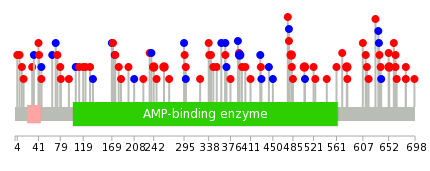 |
| Top |
| Stat. for Non-Synonymous SNVs (# total SNVs=72) | (# total SNVs=20) |
 | 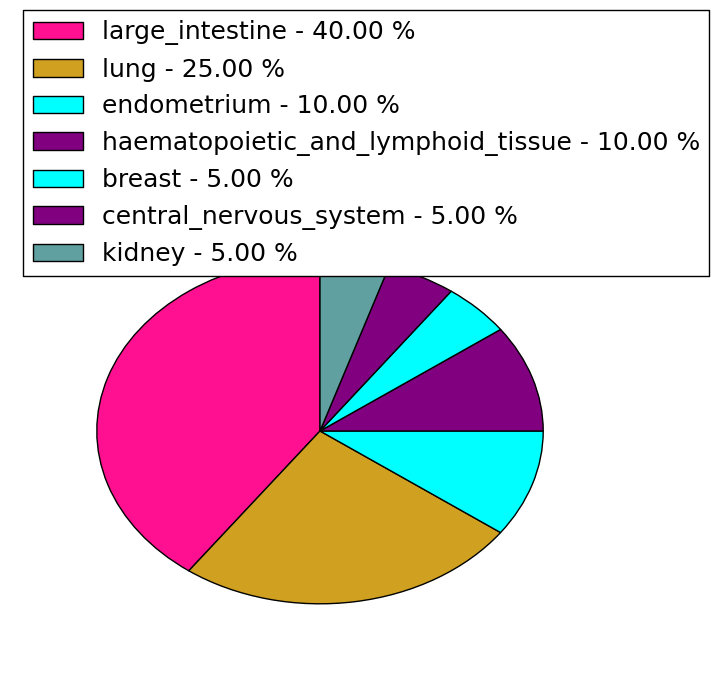 |
(# total SNVs=0) | (# total SNVs=0) |
| Top |
| * When you move the cursor on each content, you can see more deailed mutation information on the Tooltip. Those are primary_site,primary_histology,mutation(aa),pubmedID. |
| GRCh37 position | Mutation(aa) | Unique sampleID count |
| chr4:185724638-185724638 | p.R11* | 4 |
| chr4:185684329-185684329 | p.E505K | 2 |
| chr4:185681557-185681557 | p.R579Q | 2 |
| chr4:185684398-185684398 | p.A482S | 2 |
| chr4:185695007-185695007 | p.R260Q | 2 |
| chr4:185697670-185697670 | p.G242W | 2 |
| chr4:185687863-185687863 | p.F392F | 2 |
| chr4:185678418-185678418 | p.V653G | 2 |
| chr4:185689471-185689471 | p.R376Q | 1 |
| chr4:185701555-185701555 | p.A136A | 1 |
| Top |
|
 |
| Point Mutation/ Tissue ID | 1 | 2 | 3 | 4 | 5 | 6 | 7 | 8 | 9 | 10 | 11 | 12 | 13 | 14 | 15 | 16 | 17 | 18 | 19 | 20 |
| # sample | 1 | 1 | 9 | 1 | 1 | 4 | 1 | 14 | 3 | 1 | 8 | 2 | 9 | |||||||
| # mutation | 1 | 1 | 11 | 1 | 1 | 4 | 1 | 15 | 3 | 1 | 8 | 2 | 14 | |||||||
| nonsynonymous SNV | 1 | 7 | 1 | 1 | 3 | 1 | 11 | 2 | 1 | 3 | 2 | 12 | ||||||||
| synonymous SNV | 1 | 4 | 1 | 4 | 1 | 5 | 2 |
| cf) Tissue ID; Tissue type (1; BLCA[Bladder Urothelial Carcinoma], 2; BRCA[Breast invasive carcinoma], 3; CESC[Cervical squamous cell carcinoma and endocervical adenocarcinoma], 4; COAD[Colon adenocarcinoma], 5; GBM[Glioblastoma multiforme], 6; Glioma Low Grade, 7; HNSC[Head and Neck squamous cell carcinoma], 8; KICH[Kidney Chromophobe], 9; KIRC[Kidney renal clear cell carcinoma], 10; KIRP[Kidney renal papillary cell carcinoma], 11; LAML[Acute Myeloid Leukemia], 12; LUAD[Lung adenocarcinoma], 13; LUSC[Lung squamous cell carcinoma], 14; OV[Ovarian serous cystadenocarcinoma ], 15; PAAD[Pancreatic adenocarcinoma], 16; PRAD[Prostate adenocarcinoma], 17; SKCM[Skin Cutaneous Melanoma], 18:STAD[Stomach adenocarcinoma], 19:THCA[Thyroid carcinoma], 20:UCEC[Uterine Corpus Endometrial Carcinoma]) |
| Top |
| * We represented just top 10 SNVs. When you move the cursor on each content, you can see more deailed mutation information on the Tooltip. Those are primary_site, primary_histology, mutation(aa), pubmedID. |
| Genomic Position | Mutation(aa) | Unique sampleID count |
| chr4:185705138 | p.G106G,ACSL1 | 2 |
| chr4:185697670 | p.G208W,ACSL1 | 2 |
| chr4:185684408 | p.P333P,ACSL1 | 1 |
| chr4:185724635 | p.I190M,ACSL1 | 1 |
| chr4:185689498 | p.L15P,ACSL1 | 1 |
| chr4:185697653 | p.Y543C,ACSL1 | 1 |
| chr4:185679022 | p.P333L,ACSL1 | 1 |
| chr4:185709801 | p.L174L,ACSL1 | 1 |
| chr4:185686012 | p.M12V,ACSL1 | 1 |
| chr4:185724659 | p.K527N,ACSL1 | 1 |
| * Copy number data were extracted from TCGA using R package TCGA-Assembler. The URLs of all public data files on TCGA DCC data server were gathered on Jan-05-2015. Function ProcessCNAData in TCGA-Assembler package was used to obtain gene-level copy number value which is calculated as the average copy number of the genomic region of a gene. |
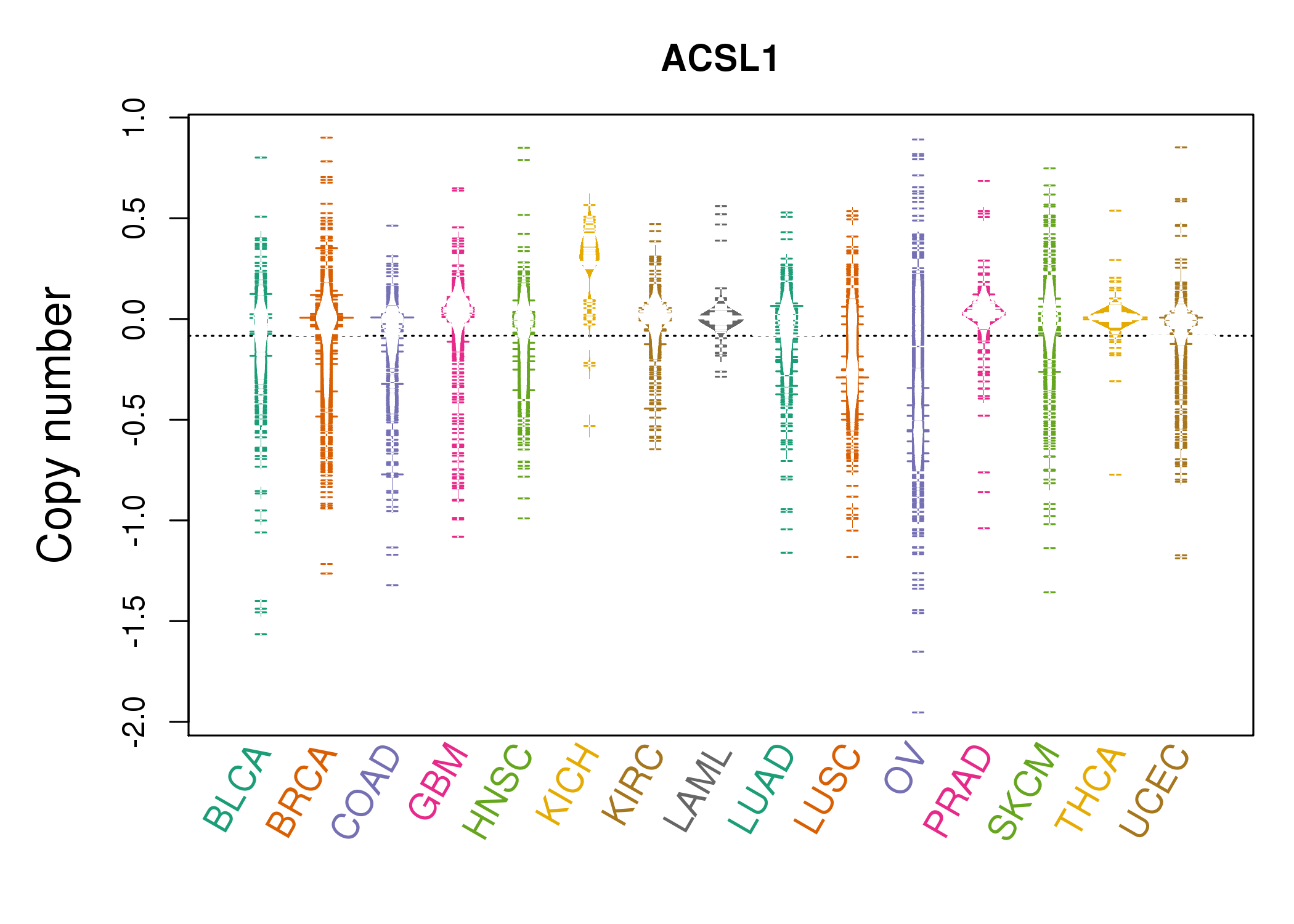 |
| cf) Tissue ID[Tissue type]: BLCA[Bladder Urothelial Carcinoma], BRCA[Breast invasive carcinoma], CESC[Cervical squamous cell carcinoma and endocervical adenocarcinoma], COAD[Colon adenocarcinoma], GBM[Glioblastoma multiforme], Glioma Low Grade, HNSC[Head and Neck squamous cell carcinoma], KICH[Kidney Chromophobe], KIRC[Kidney renal clear cell carcinoma], KIRP[Kidney renal papillary cell carcinoma], LAML[Acute Myeloid Leukemia], LUAD[Lung adenocarcinoma], LUSC[Lung squamous cell carcinoma], OV[Ovarian serous cystadenocarcinoma ], PAAD[Pancreatic adenocarcinoma], PRAD[Prostate adenocarcinoma], SKCM[Skin Cutaneous Melanoma], STAD[Stomach adenocarcinoma], THCA[Thyroid carcinoma], UCEC[Uterine Corpus Endometrial Carcinoma] |
| Top |
| Gene Expression for ACSL1 |
| * CCLE gene expression data were extracted from CCLE_Expression_Entrez_2012-10-18.res: Gene-centric RMA-normalized mRNA expression data. |
 |
| * Normalized gene expression data of RNASeqV2 was extracted from TCGA using R package TCGA-Assembler. The URLs of all public data files on TCGA DCC data server were gathered at Jan-05-2015. Only eight cancer types have enough normal control samples for differential expression analysis. (t test, adjusted p<0.05 (using Benjamini-Hochberg FDR)) |
 |
| Top |
| * This plots show the correlation between CNV and gene expression. |
: Open all plots for all cancer types
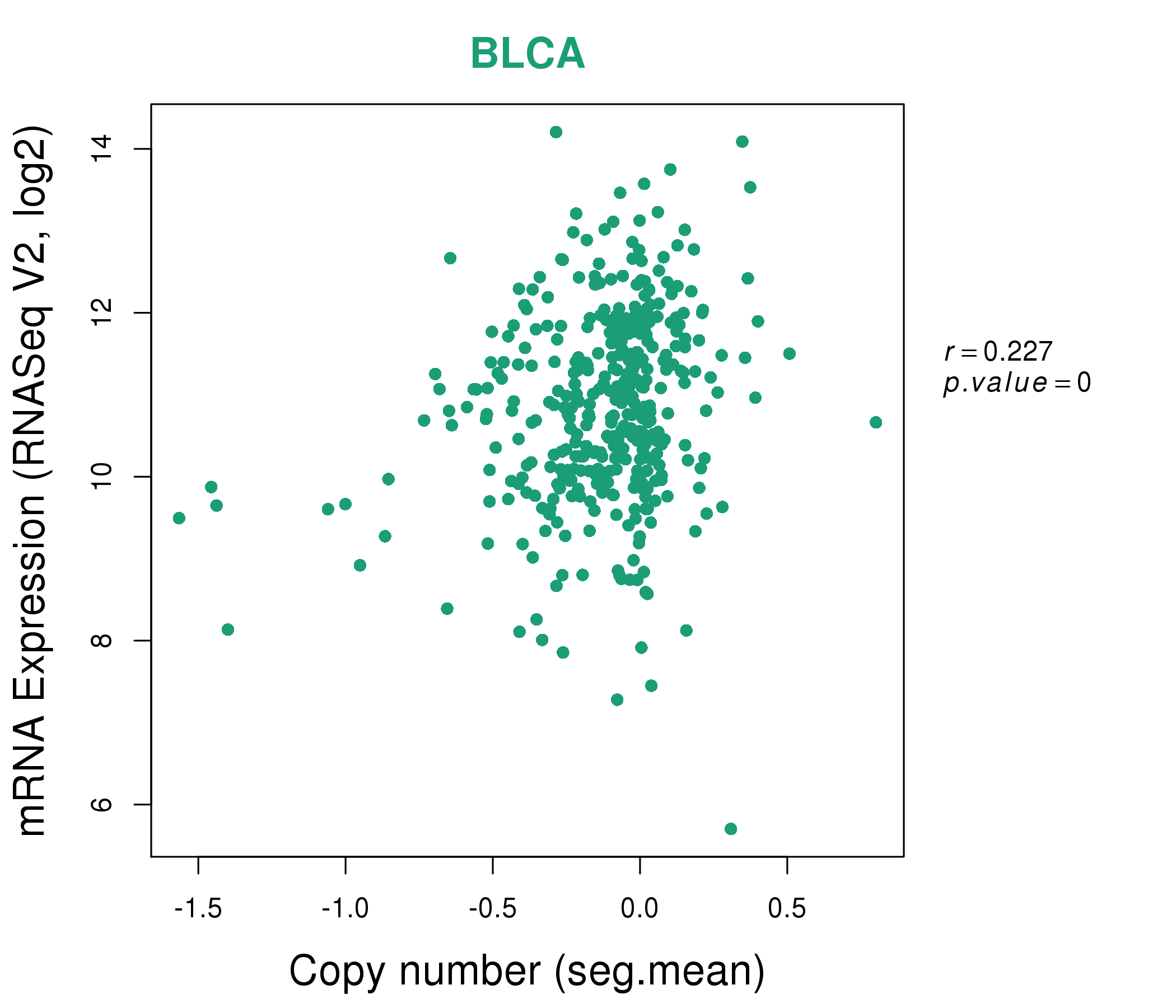 |
|
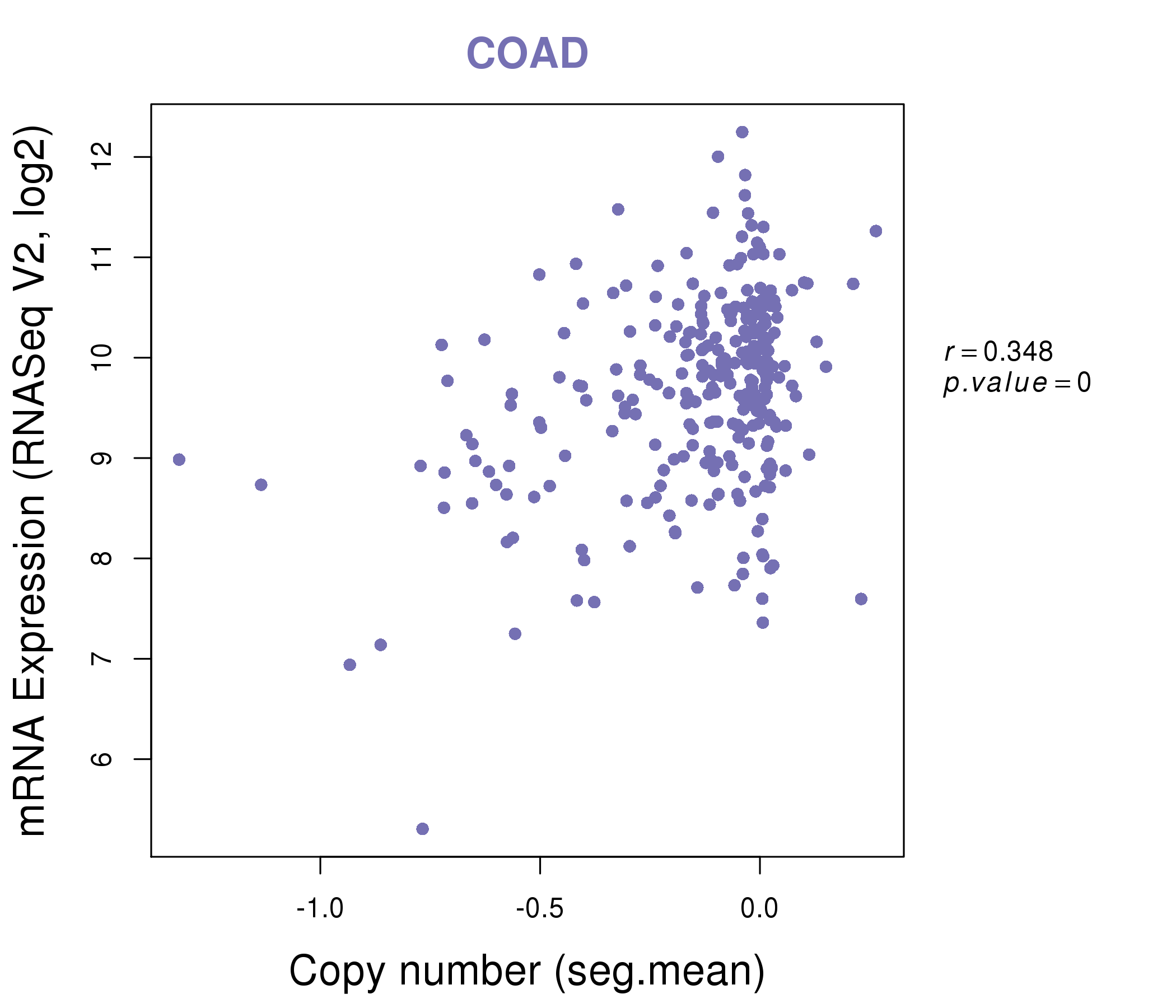 |
|
| Top |
| Gene-Gene Network Information |
| * Co-Expression network figures were drawn using R package igraph. Only the top 20 genes with the highest correlations were shown. Red circle: input gene, orange circle: cell metabolism gene, sky circle: other gene |
: Open all plots for all cancer types
 |
| ||||
| AADAT,ACSL1,AKR1B15,AKR1D1,ATP13A4,C6orf223,CLDN8, FCN2,FKBP5,GRAMD2,IDI1,LST-3TM12,MYOM2,NAMPT, PNLIPRP3,RLN3,RNASE12,SC5D,SLC41A2,SPINK8,SRD5A1 | ABCD2,ACACB,ACOT1,ACOT2,ACSL1,ACSS2,BOK, CIDEC,DGAT1,FAH,GBE1,GPAM,GYG2,HEPACAM, HEPN1,LGALS12,LPL,MARC1,MTHFD1,PDE3B,PECR | ||||
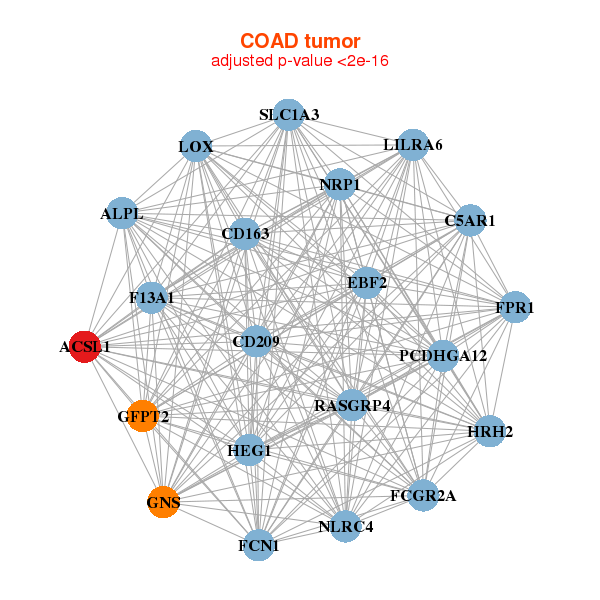 |
| ||||
| ACSL1,ALPL,C5AR1,CD163,CD209,EBF2,F13A1, FCGR2A,FCN1,FPR1,GFPT2,GNS,HEG1,HRH2, LILRA6,LOX,NLRC4,NRP1,PCDHGA12,RASGRP4,SLC1A3 | ACSL1,C6orf223,CACNA1E,DGAT2,DZIP1L,FASN,FCN2, GPAM,GYS2,HTR5A,LGALS12,LPL,MRAP,PLIN5, PLXNA4,SAA1,SAA2,SCD,SH3RF3,SPINK13,THRSP |
| * Co-Expression network figures were drawn using R package igraph. Only the top 20 genes with the highest correlations were shown. Red circle: input gene, orange circle: cell metabolism gene, sky circle: other gene |
: Open all plots for all cancer types
| Top |
: Open all interacting genes' information including KEGG pathway for all interacting genes from DAVID
| Top |
| Pharmacological Information for ACSL1 |
| DB Category | DB Name | DB's ID and Url link |
| * Gene Centered Interaction Network. |
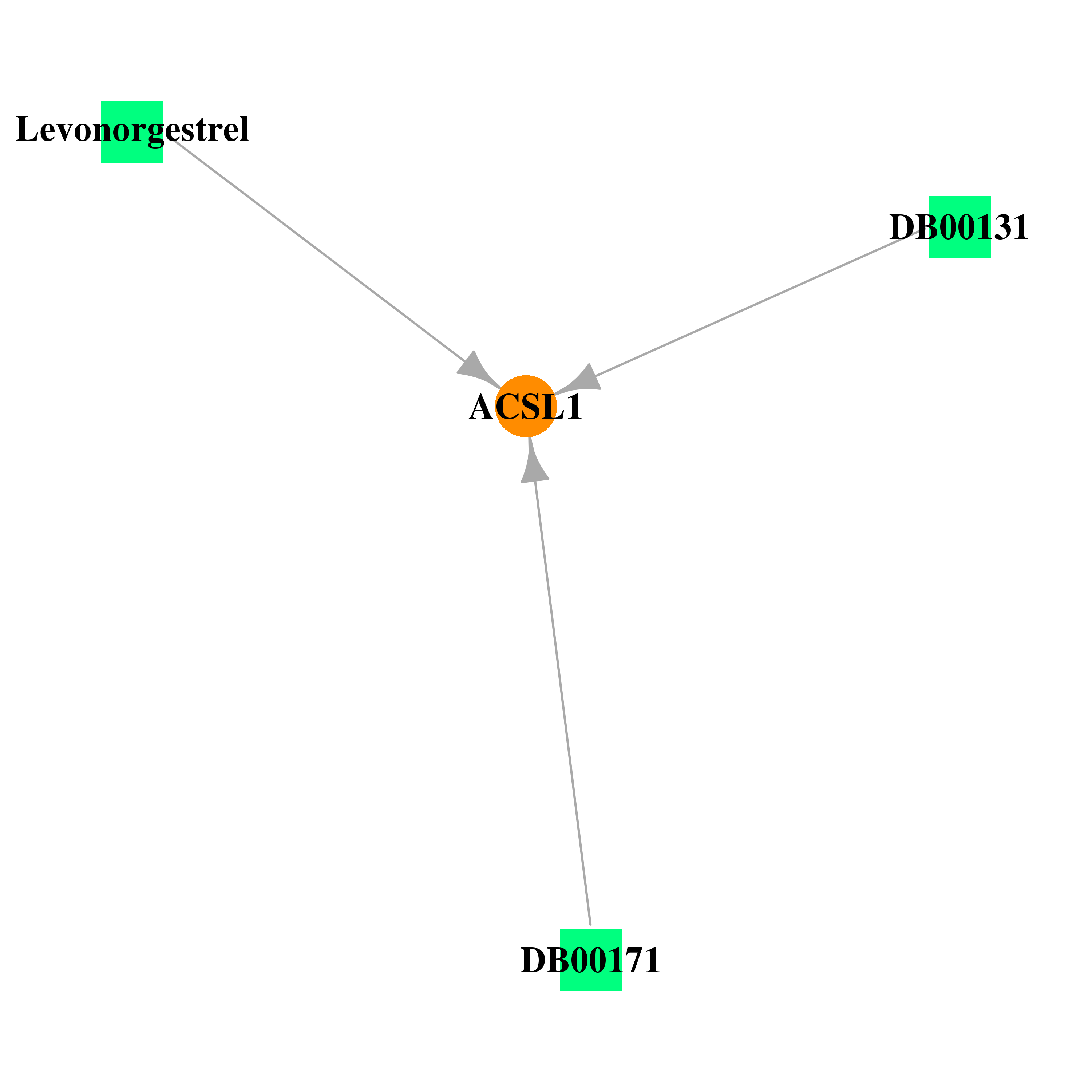 |
| * Drug Centered Interaction Network. |
| DrugBank ID | Target Name | Drug Groups | Generic Name | Drug Centered Network | Drug Structure |
| DB00131 | acyl-CoA synthetase long-chain family member 1 | approved; nutraceutical | Adenosine monophosphate |  | 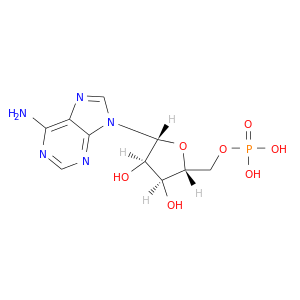 |
| DB00171 | acyl-CoA synthetase long-chain family member 1 | approved; nutraceutical | Adenosine triphosphate |  |  |
| DB00367 | acyl-CoA synthetase long-chain family member 1 | approved; investigational | Levonorgestrel |  |  |
| Top |
| Cross referenced IDs for ACSL1 |
| * We obtained these cross-references from Uniprot database. It covers 150 different DBs, 18 categories. http://www.uniprot.org/help/cross_references_section |
: Open all cross reference information
|
Copyright © 2016-Present - The Univsersity of Texas Health Science Center at Houston @ |







